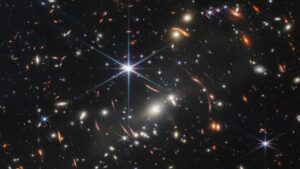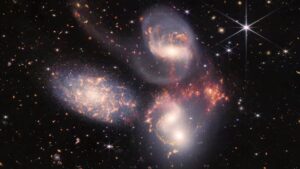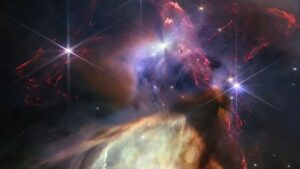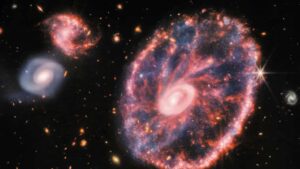James Webb telescope discoveries are shaking our knowledge of the universe, especially concerning the unknowable indication of dark matter. The images, findings and research work via this telescope have put forward the incredible of space and what could be seen as a thing of far past. According to a recent analysis of telescope data by astronomers, some of the oldest galaxies are significantly larger and brighter than expected, which might put the conventional model that has administered cosmology for decades in difficulty.
This unexpected finding is similar to a distinct hypothesis known as Modified Newtonian Dynamics (MOND), which suggests that the laws of gravity might act differently on a cosmic scale than was previously thought. These results imply that JWST is a technology that has the potential to revolutionize our knowledge of the processes forming the universe besides providing a powerful window into the far past.
Simply put, James Webb Space Telescope Makes Surprising Galactic Findings That Cast Doubt on Dark Matter
Recent unexpected James Webb telescope discoveries could fundamentally alter our view of the cosmos, particularly concerning the enigmatic idea of dark matter. This unexpected finding calls into question the accepted theory of dark matter, which has long served as the basis for cosmology.
James Webb telescope discoveries: A Guide to Dark Matter

Scientists have suspected for decades that stars, galaxies, and other cosmic bodies are subject to a force that is invisible to the naked eye. The unknown material known as dark matter, which is thought to make up around 27% of the universe, has been blamed for this “extra” force. We cannot see dark matter because it does not emit energy or light. Nonetheless, over billions of years, its actions are believed to have shaped the structure and evolution of galaxies.
The conventional cosmological model, which also includes dark energy, a force pushing the expansion of the universe, and ordinary matter, such as stars and planets, has made dark matter a major player. This hypothesis postulated that galaxies developed gradually and hierarchically throughout time, with tiny pieces joining to form larger structures.
However, some of these theories are called into question by the latest James Webb telescope results.
Researchers anticipated seeing tiny, faint structures consistent with cold dark matter hypotheses when the James Webb telescope concentrated on galaxies in the early universe. Rather, they saw galaxies that were remarkably brilliant and massive, suggesting that they had grown and developed speedily. If dark matter was the primary agent influencing the early history of galaxies, this discovery would go against what scientists would anticipate.
The expectation was that every big galaxy we see in the nearby universe would have started from these itty-bitty pieces.
This finding raises the possibility that there was another force at play, one that would have been more appropriate in explaining the early universe’s rapid development of these galaxies.
Modified Newtonian Dynamics (MOND): An Alternative Theory

Now let’s talk about MOND. MOND, a theory contends that gravity works differently than Isaac Newton’s theory would at very weak scales, such as the margins of galaxies. MOND suggests that the rules of gravity alter under specific circumstances rather than presuming that an unseen substance (dark matter) must be at work.
MOND has been a specialized theory with dedicated supporters and critics for more than 40 years. Even while MOND has been successful in predicting some galaxy behaviors, it is difficult to integrate into a single cosmological framework since it does not account for all known phenomena, especially those that dark matter is best able to explain. However, the latest data from JWST, which reveals larger and brighter galaxies much earlier than anticipated, is in good agreement with MOND’s predictions, indicating that it would be worth more research.
So, is dark matter no longer relevant?

No, not quite yet, is the quick answer. Due to its ability to explain a wide range of cosmic observations, including as the rates at which a galaxy rotates, their spatial distribution, and the presence of gravitational lensing, dark matter continues to be the most popular explanation. The JWST results, however, point to significant irregularities that dark matter models find difficult to account for.
Because the new data might have alternative interpretations, scientists are still hesitant to accept MOND or rule out dark matter. For example, supermassive black holes rather than galaxies may be the source of some of the extraordinarily brilliant sources observed by JWST. This could explain a portion of the brightness, but it doesn’t solve the problem of fast galactic expansion.
Nonetheless, now, astronomers are faced with a fascinating challenge: they are torn between two hypotheses that provide conflicting accounts of how the universe behaves. Dark matter, a theory that has emerged as a key idea in modern astrophysics and that explains most but not all observable events, is on one side. MOND, on the other hand, is a less well-known theory that nevertheless fits in nicely with some of the recent James Webb telescope discoveries.

A new chapter in the dark matter controversy has been started by the James Webb telescope results, which have raised significant issues and offered new insights. Although it’s too soon to say if MOND will eventually displace dark matter in the eyes of science, this study pushes physicists to consider other theories and deepen their knowledge of gravity, galaxy formation, and the basic laws of nature.
JWST will carry on observing the universe’s distant past in the upcoming years, providing even more in-depth insights into the circumstances surrounding the first galaxies. These findings could revolutionize our knowledge of the universe by giving us additional information to test the limitations of the dark matter and MOND hypotheses.
The topic of what actually influences the development and behavior of galaxies in our universe is still unanswered.













